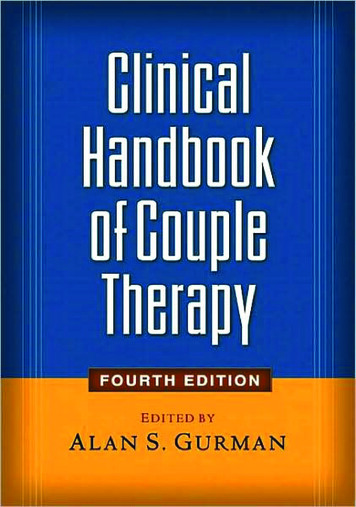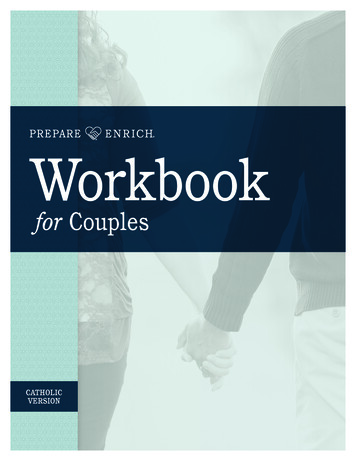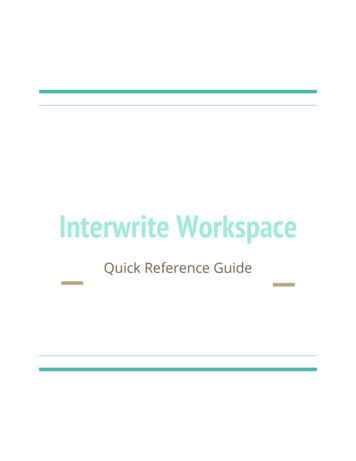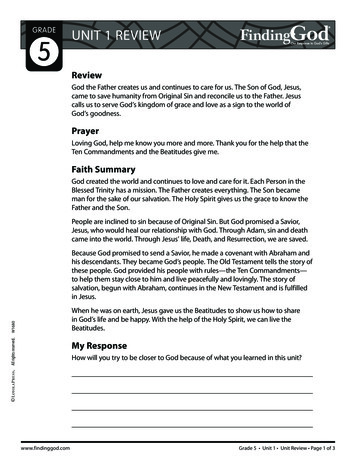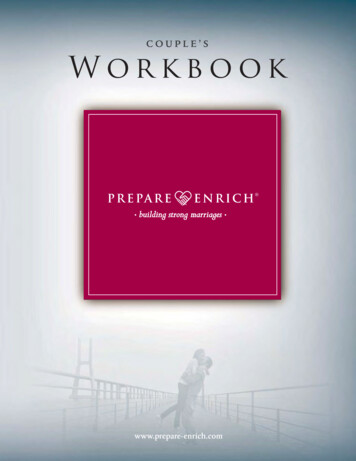
Transcription
COUPLE’SWorkbook www.prepare-enrich.com
COUPLE’S WORKBOOKTABLE OF CONTENTS*SHARING STRENGTH AND GROWTH AREAS . . . . . . . . . . . . . . . . . . . . . 2COMMUNICATION: Assertiveness and Active Listening. . . . . . . . . . . . . . . . . . 3* Creating a Wish List using Assertiveness and Active Listening. . . . .Daily Dialogue and Daily Compliments . . . . . . . . . . . . . . . . .PERSONAL STRESS PROFILE:Most Critical Issues* IdentifyingBalancing your Priorities . . . . . . . . . . . . . . . . . . . . . . . . . . . . . . . . . . . . . . . . . . . .Wedding Stress . . . . . . . . . . . . . . . . . . . . . . . . . . . . . .45678CONFLICT RESOLUTION:Steps for Resolving Conflict* TenHow to take a Time-Out . . . . . . . . . . . . . . . . . . . . . . . . 9. . . . . . . . . . . . . . . . . . . . . 10Seeking and Granting Forgiveness . . . . . . . . . . . . . . . . . . . . 11FINANCIAL MANAGEMENT:The Challenges of Money . . .Importance of Financial GoalsBudget Worksheet . . . . . .The Meaning of Money . . .12131415LEISURE ACTIVITIES: The Dating Exercise . . . . . . . . . . . . . . . . . . . . . . 16SEX AND AFFECTION: The Expression of Intimacy . . . . . . . . . . . . . . . . . 17RELATIONSHIP ROLES: Sharing Roles . . . . . . . . . . . . . . . . . . . . . . . . 18SPIRITUAL BELIEFS: Your Spiritual Journey . . . . . . . . . . . . . . . . . . . . .19MARRIAGE EXPECTATIONS: Managing Your Expectations . . . . . . . . . . . . .20CHILDREN AND PARENTING:Couple Discussion about Children . . . . . . . . . . . . . . . . . . . 21Planning a Weekly Family Conference . . . . . . . . . . . . . . . . . . 21StepFamilies: Choosing Realistic Expectations . . . . . . . . . . . . . 22FAMILY MAPS:* COUPLE ANDMappingYour Relationship. . . . . . . . . . . . . . . . . . . . . . 23Closeness Exercises . . . . . . . . . . . . . . . . . . . . . . . . . . . 25Flexibility Exercises . . . . . . . . . . . . . . . . . . . . . . . . . . . 26* PERSONALITY: SCOPE Out Your Personality . . . . . . . . . . . . . . . . . . .27GOALS: Achieving Your Goals.Together . . . . . . . . . . . . . . . . . . . . . . . 28* SIX CORE EXERCISES
SHARING STRENGTH AND GROWTH AREAS“Your strengths develop by working through your issues.”Check what areas you agree or disagree most with your partner. Select three Strength Areas (most agreement and positive aspects of your relationship) Select three Growth Areas (most disagreement and areas you want to improve)STRENGTHAREASGROWTHAREAS1. COMMUNICATIONWe share feelings and understand each other.2. CONFLICT RESOLUTIONWe are able to discuss and resolve differences.3. PARTNER STYLE AND HABITSWe appreciate each other’s personality and habits.4. FINANCIAL MANAGEMENTWe agree on budget and financial matters.5. LEISURE ACTIVITIESWe have a good balance of activities together and apart.6. SEXUALITY AND AFFECTIONWe are comfortable discussing sexual issues and affection.7. FAMILY AND FRIENDSWe feel good about our relationships with relatives and friends.8. RELATIONSHIP ROLESWe agree on how to share decision-making and responsibilities.9. CHILDREN AND PARENTINGWe agree on issues related to having and raising children.10. SPIRITUAL BELIEFSWe hold similar religious values and beliefs.COUPLE DISCUSSION:1. Take turns sharing what each of you perceive as your relationship strengths. Verbally share onestrength at a time, until you each have shared three.2. Use the same procedure to share and discuss growth areas.3. Now have a discussion around these questions:a. Did any of your partner’s responses surprise you?b. In what areas did you mostly agree with your partner?c. In what areas did you mostly disagree with your partner?2www.prepare-enrich.com Copyright 2008, 2015
COMMUNICATION“It takes two to speak the truth.one to speak and another to hear.”—Henry David ThoreauASSERTIVENESS AND ACTIVE LISTENINGASSERTIVENESS:Assertiveness is the ability to express your feelings and ask for what you want in the relationship.Assertiveness is a valuable communication skill. In successful couples, both individuals tend to be quiteassertive. Rather than assuming their partner can read their minds, they share how they feel and askclearly and directly for what they want.Assertive individuals take responsibility for their messages by using “I” statements. They avoid statementsbeginning with “you.” In making constructive requests, they are positive and respectful in their communication.They use polite phrases such as “please” and “thank you”.Examples of Assertive Statements:“I’m feeling out of balance. While I love spending time with you, I also want to spend time with myfriends. I would like us to find some time to talk about this.”“I want to take a ski vacation next winter, but I know you like to go to the beach. I’m feeling confusedabout what choice we should make.”ACTIVE LISTENING:Active listening is the ability to let your partner know you understand them by restating theirmessage.Good communication depends on you carefully listening to another person. Active listening involveslistening attentively without interruption and then restating what was heard. Acknowledge content ANDthe feelings of the speaker. The active listening process lets the sender know whether or not the messagethey sent was clearly understood by having the listener restate what they heard.Examples of Active Listening:“I heard you say you are feeling ‘out of balance’, and enjoy the time we spend together but thatyou also need more time to be with your friends. You want to plan a time to talk about this.”“If I understand what you said, you are concerned because you want to go skiing next winter.But you think I would rather to go to the beach. Is that correct?”When each person knows what the other person feels and wants (assertiveness) andwhen each knows they have been heard and understood (active listening), intimacy isincreased. These two communication skills can help you grow closer as a couple.www.prepare-enrich.com Copyright 2008, 20153
COMMUNICATION“It is a luxury to be understood.”—Ralph Waldo EmersonCREATING A WISH LISTIn this exercise, you will each individually make a Wish List of things you would like more or less of inyour relationship. Next, take turns sharing your Wish Lists with each other.Assertiveness is the ability to express your feelings and ask for what you want in your relationship.Active listening is the ability to let your partner know you understand them by restating their message.In sharing your Wish List with your partner, you will be demonstrating your Assertiveness skills. In givingfeedback to your partner about their Wish List, you will be demonstrating your Active Listening skills.Make a Wish List of three things you would like more or less of in your relationship.1.2.3.COUPLE DISCUSSION:Take turns sharing your Wish List with each other.SPEAKER’S JOB:1. Speak for yourself (“I” statements e.g. ”I wish.”)2. Describe how you would feel if your wish came true.LISTENER’S JOB:1. Repeat/summarize what you have heard.2. Describe the wish AND how your partner would feel if the wish came true.After completing the Wish List Exercise, discuss the following questions:How good were each of you at being assertive?In what ways did you each effectively use active listening skills?4www.prepare-enrich.com Copyright 2008, 2015
COMMUNICATION“Marriage is a team sport; you either win together or lose together.”DAILY DIALOGUE AND DAILY COMPLIMENTSDaily Dialogue is an intentional effort to talk about your relationship, rather than discussing your activities that day. The focus of this dialogue should be on your feelings about each other and your livestogether. Set aside five minutes per day to discuss the following: What did you most enjoy about your relationship today? What was dissatisfying about your relationship today? How can you be helpful to each other?Daily Compliments help you focus on the positive things you like about each other. Every day give yourpartner at least one genuine compliment. These can be general (“you are fun to be with”) or specific(“I appreciate that you were on time for the concert”). COMMUNICATION SKILLS TO INCREASE INTIMACY 1. Give full attention to your partner when talking. Turn off the phone, shutoff the television, make eye contact.2. Focus on the good qualities in each other and often praise each other.3. Be assertive. Share your thoughts, feelings, and needs.A good way to be assertive without being critical is to use “I” rather than “You”statements. (e.g. “I worry when you don’t let me know you’ll be late” rather than “You arealways late”).4. Avoid criticism.5. If you must criticize, balance it with at least one positive comment.(e.g.“I appreciate how you take the trash out each week. In the future can you remember toalso wheel the trash can back from the end of the driveway?” ) .6. Listen to understand, not to judge.7. Use active listening. Summarize your partner’s comments before sharing yourown reactions or feelings.8. Avoid blaming each other and work together for a solution.9. Use the Ten Steps approach. For problems that come up again and again, usethe Ten Steps for Resolving Couple Conflict.10. Seek counseling. If you are not able to resolve issues, seek counseling beforethey become more serious.www.prepare-enrich.com Copyright 2008, 20155
PERSONAL STRESS PROFILE“Grant me the serenity to accept the things I cannot change; the courage to change the thingsI can; and the wisdom to know the difference.” —Reinhold NiebuhrIDENTIFYING MOST CRITICAL ISSUESDo you control stress in your life or does stress control you?Stressors are events that cause an emotional and/or physical reaction. Stress can be positive (wedding,job promotion) or negative (loss of job, car accident, major illness). But what is important is to be ableto manage the many stressors in your life.One way to manage stress is to prioritize the issues that are most important to you. Another is to decidewhat issues can be changed or resolved and which ones cannot. This exercise will help you focus on thehigh priority issues and those that can be changed (Box 1).Couple Exercise:1. Select up to four issues that are the most stressful for each of you.2. Review each issue and put it into one of the four cells below.3. Box 1 contains the “Most Critical Issues.”Able to ChangeDifficult to ChangeBox 1: Most Critical IssuesBox 2What changes can you each make?Box 3How do you plan to cope?Box 4: Least Critical IssuesAre you spending too much timeon low priority issues?Can you accept or forget about these issues?HighPriorityLowPriorityCOUPLE DISCUSSION:Select one issue from Box 1 that you will work on together as a couple.Work together as a team to achieve your goals.1. Communicate about the issue.2. Use good conflict resolution skills.3. Be flexible with one another.6www.prepare-enrich.com Copyright 2008, 2015
PERSONAL STRESS PROFILE“You can’t stop the waves, but you can learn to surf.”—Jon Kabat-ZinnBALANCING YOUR PRIORITIESFirst, indicate how much time you “Now” spend on each of these areas. Next, decide on the amount of timeyou would ideally spend—“Your Goal”. Then decide how you can achieve your goal.WORK:Time on job/schoolBringing work homeCommutingNOWYOUR GOAL(Hours per week)How will you movetoward your goal?PERSONAL:ExerciseTelevisionComputer/video gamesHobby/RecreationReadingFriendsReligious activitiesVolunteeringSleep (hours per night)MARRIAGE: (Couple)At home togetherActivities/DatesDiscussions (minutes per day)HOME:CleaningCookingGrocery shoppingErrandsLawn/GardenHome maintenanceFAMILY: (if children at home)Number of meals togetherFamily activitiesTransporting childrenHelping with homeworkAt home togetherCOUPLE DISCUSSION: What areas feel out of balance to each of you? What steps must you take in order for your goal to become reality?www.prepare-enrich.com Copyright 2008, 20157
PERSONAL STRESS PROFILEWEDDING STRESSDifferences and disagreements are as inevitable in wedding planning as they are in marriage itself. Thisis a good time to learn how to deal with them. Here are some strategies you might find helpful:1. Consider the big picture as it affects each decision. Some decisions will be made consequentially as other wishesare discussed. For example, the guest list should be created early because it shapes decisions about facilitiesand costs, among other things. If one of you wants a tropical beach wedding and the other a home- townwedding, you can discuss these options in the light of other issues such as the fact both of you want your frailgrandparents to come to your wedding. Seeing the larger picture can help you resolve differences.2. Ask yourselves who cares more about the issue. You can decide to gracefully adjust your preference if your partner has strong feelings about an issue. You may prefer a small, intimate wedding but your partner hascherished the family tradition of a large wedding. Try setting a number that gives more to the person whocares the most.3. Periodically assess your wedding-planning stress and feelings of competency. If your partner has not followedthrough on a task they were responsible for, or if you feel better equipped for a particular task, politely offerto help or take over (e.g., “I am interested in photography and have a light work schedule next week. Is it okay if I researcha photographer?” ). The key is to agree together on a shift of responsibility, rather than saying, “Since you won’t doit, I will!” The person who has been relieved of one responsibility should then offer to help with other responsibilities.4. Teach and learn from one another rather than assuming the other “gets it.” Sometimes one of you will notsee a problem that is quite clear to the other. You can both educate each other about your families and theirtraditions. The groom from a Catholic family should explain to his Protestant bride what is involved in atraditional Catholic wedding, rather than having surprises keep coming up.5. When you are doing your best to deal with your differences and yet remain polarized, consider whether deeper issuesare underlying your conflict. For example, sometimes the issue is not about the size of the weddingbut about a feeling of envy or competition because one of you has a bigger family or circle of friends.Sometimes the issue is not between the two of you, but between one of you and your family members.The standard tools of effective communication taught in PREPARE/ENRICH are particularly important whenthere is tension between you. Examples are speaking for yourself using “I-statements” rather than attacking theother person, listening to understand before proposing solutions, and choosing the best time and place to talkabout difficult matters. Your everyday communication patterns might be fine for everyday matters, but whenyou are negotiating a wedding, it’s good to be at your best!8www.prepare-enrich.com Copyright 2008, 2015
CONFLICT RESOLUTIONTEN STEPS FOR RESOLVING CONFLICTAll couples have differences and disagreements. Studies show the amount of disagreements are not relatedto marital happiness as much as how they are handled. Happy couples do not avoid disagreements; theyresolve them while remaining respectful of each other, thereby strengthening their relationship. This TenStep Model is a simple, but effective way to resolve conflict while avoiding the common and destructivepatterns. Use this model with an ongoing issue in your relationship, as well as future issues.1. Set a time and place for discussion.2. Define the problem - Be specific.3. List the ways you each contribute to the problem.Partner 1:Partner 2:4. List past attempts to resolve the issue that were not successful.1)3)2)4)5. Brainstorm—Pool your new ideas and try to list 10 possible solutions to the problem. Do not judgeor criticize any of the suggestions at this point.1)6)2)7)3)8)4)9)5)10)6. Discuss and evaluate each of these possible solutions. (Be as objective as possible. Talk about howuseful and appropriate each suggestion feels for resolving your issue.)7. Agree on one solution to try.8. Agree how you will each work toward this solution. (Be as specific as possible.)Partner 1:Partner 2:9. Set up another meeting to discuss your progress.Place:Date:Time:10. Reward each other for progress. (If you notice your partner making a positive contribution towardthe solution, praise his/her effort.)www.prepare-enrich.com Copyright 2008, 20159
CONFLICT RESOLUTION“Anyone can become angry. That is easy. But to be angry with the right person, to the rightdegree, at the right time, for the right purpose and in the right way – that is not easy.”—AristotleHOW TO TAKE A TIME-OUTSome conflicts become heated as levels of anger and frustration rise. Rather than speaking assertively, partners begin to accuse, criticize, or yell. Rather than listening actively, partners interrupt, belittle, and ignore.Physiologically, the “fight or flight” response is triggered as each person goes into a protection mode withlittle or no regard for their partner. In this state of escalation, it is not uncommon to say or do things welater regret. Moreover, it is nearly impossible to have a productive conversation leading to a mutually agreedupon resolution. This is when a “time-out” can be beneficial. A time-out provides couples with an opportunity to cool down, identify their feelings and needs, and begin to think productively again about how toapproach the issues they face.1. RECOGNIZE your need for a time-out. Are your fists clenched? Is your face red? Are you breathingfast? Are the tears streaming down your face? Do you feel like screaming or throwing something?Are you afraid of your partner’s intensity? Do you feel emotionally closed off ? Learn to recognize the signs that things have become too intense for you to have a productiveinteraction with your partner. What physical and emotional reactions indicate you need a time-out?2. REQUEST THE TIME-OUT. Call a time-out for yourself by saying something like “I’m just too angryto talk right now; I need to take a time-out. Please give me an hour to calm down and gather my thoughts.” Remember to call the time-out for yourself. It is seldom helpful to tell the other person “Youneed a time-out!” Suggest a time when you think you’ll be ready to resume.3. RELAX AND CALM DOWN. Take some deep breaths. Go for a jog. Take a walk or a bath. Write inyour journal. Read, pray, or watch television for a while. Do something that will help you relax and recover from the emotional intensity. What method(s) could you use to calm down?4. REMEMBER WHAT’S IMPORTANT. Try to identify what you were thinking and feeling that became so difficult to discuss. Think about “I” messages you could use to tell your partner what you were thinking or feeling,and what you need from him/her. Try to spend some quiet time considering your partner’s point of view and what they are feeling. Remember the two of you are a team, and the only way your relationship will “win” is if you worktoward a solution that both individuals can feel good about.5. RESUME THE CONVERSATION. Bring in the skills of Assertiveness and Active Listening and/orthe Ten Steps for Conflict Resolution. These structured skills can help contain the intensity as you attemptto resolve a conflict. Honor your commitment to return to the issue when you are ready to have a moreproductive conversation.10www.prepare-enrich.com Copyright 2008, 2015
CONFLICT RESOLUTION“The weak can never forgive. Forgiveness is the attribute of the strong.”—Mahatma GandhiSEEKING AND GRANTING FORGIVENESSAll couples eventually experience times of conflict, hurt, and letting each other down. Sometimes theoffense is as minor as forgetting a date or failing to run an errand. For some couples, the offense mightinvolve a major betrayal such as infidelity, addiction, or abuse. Either way, taking time to seek and grantforgiveness can play a powerful role in healing and restoring the relationship.Forgiveness is the decision or choice to give up the right for vengeance, retribution, and negative thoughtstoward an offender in order to be free from anger and resentment. This process promotes healing and restorationof inner peace, and it can allow reconciliation to take place in the relationship.It is also important to be clear about what forgiveness is not. Forgiveness is not forgetting, condoning, orperpetuating injustice. Since it is sometimes unsafe or impossible, forgiveness does not always involvereconciliation. Forgiveness is not always quick; it is a process that can take time to unfold. Don’t rush yourpartner if they need to spend days or weeks working through the process of granting forgiveness.Six Steps for Seeking Forgiveness:1. Admit what you did was wrong or hurtful.2. Try to understand/empathize with the pain you have caused.3. Take responsibility for your actions and make restitution if necessary.4. Assure your partner you will not do it again.5. Apologize and ask for forgiveness.6. Forgive yourself.Six Steps for Granting Forgiveness:1. Acknowledge your pain and anger.2. Be specific about your future expectations and limits.3. Give up your right to “get even,” but insist on being treated better in the future.4. Let go of blame, resentment, and negativity toward your partner.5. Communicate your act of forgiveness to your partner.6. Work toward reconciliation (when safe).www.prepare-enrich.com Copyright 2008, 201511
FINANCIAL MANAGEMENT“Thrift used to be a basic American virtue. Now the American virtue is tospend money.” —David BrinkleyTHE CHALLENGES OF MONEYThe joining of two individuals is the joining of two different orientations to money. Our early experienceshelp shape our values about money. Money operates metaphorically in our lives, representing many otherthings such as security, nurturance, opportunity, trust, and the relationship between dependence and independence. Little wonder then that money is a major cause of conflict and a multilayered problem for married couples.Setting Financial Goals Exercise:Often goals are an extension of money orientations and should be considered together. The partner whois oriented to security is more apt to have financial goals around savings than the partner whose moneyorientation is centered around enjoyment. Create, discuss, and share financial goals in the Financial Goalsexercise.Creating a Budget Exercise:Budgeting is the process of allocating expenses on a regular basis. Budgeting puts you in control of yourspending—a process that can be very empowering in a culture where we are constantly enticed to spendmoney. One good way to create a budget is to keep track of everything you spend money on for 1-3 months,and then average your expenditures per category. Complete the Budget Worksheet as your workable budget,making sure to allot a monthly amount into ‘savings’.The Meaning of Money Exercise:In this exercise you will assess and then discuss your orientation toward money. The advantage ofunderstanding your partner’s money orientation is you can then capitalize on and balance each other’sstrengths.12www.prepare-enrich.com Copyright 2008, 2015
FINANCIAL MANAGEMENT“There is nothing wrong with men possessing riches. The wrong comes when richespossess men.”—Billy GrahamIMPORTANCE OF FINANCIAL GOALSCouples argue about finances more than any other topic. Regardless of how much or how little moneya couple has, deciding what to purchase and how to spend their money is problematic for most couples.Typically, most couples focus on only short-term financial goals like: “Today I will pay 100 on my creditcard bill.” But short-term goals should also take into consideration your long-term goals like: “We want tosave enough to make a down payment on a house.”One way to reduce the amount of conflict regarding finances is for you and your partner to discuss and decideon your short-term and long-term financial goals. Setting common goals as a couple can increase your sense ofteamwork and collaboration in this complex area of finances.Identifying and Deciding on Your Financial GoalsEach person should individually brainstorm their short-term and long-term financial goals and then sharethem with each other. Short-term goals should be what you can achieve in six months to one year. Long termgoals might be achieved from one to five years. Remember, your goals should be realistic, clear and specific.Short-Term Goals: (six months to one year)1.2.3.Long-Term Goals: (one to five years)1.2.3.COUPLE DISCUSSION: Share your lists with one another. What do they have in common? Where are they different? Decide together as a couple on your common goals. Talk about how you can each contribute to achieving these goals. Revisit them from time to time so you stay on track.www.prepare-enrich.com Copyright 2008, 201513
FINANCIAL MANAGEMENTBUDGET WORKSHEETMONTHLY INCOME: (Take Home Pay)Total Partner 1:Total Partner 2:TOTAL COUPLE:MONTHLY EXPENSESGIVING Contributions/Tithe:HOUSING Rent or Mortgage:Current SpendingUtilities:Phone:LOANS/DEBT Auto:Personal:Credit Cards:CAR Gasoline:Repairs/Maintenance:FOOD Food at home:Food away from home:HEALTH CAREINSURANCE Medical:Car:Home/Life/Health:CLOTHINGPERSONAL GOODSHOUSEHOLD SUPPLIESSERVICES Cell phone:Cable/Dish:Internet:Dry Cleaning/Laundry:Other:OTHER EXPENDITURES Savings:Gifts:Entertainment:Daycare:Child support:Other:TOTAL COUPLE INCOME:TOTAL EXPENSES:SURPLUS OR DEFICIT:14www.prepare-enrich.com Copyright 2008, 2015Future Budget Plan
FINANCIAL ee5StronglyAgreeTHE MEANING OF MONEYUse the 1-5 scale to respond to each of the statements below:1. I look up to people who have been very financially successful.2. In making a major purchase, I consider what others will think of my choice.3. Having high quality things reflects well on me.4. It is important for me to maintain a lifestyle similar to or better than that of my peers.5. Having some money in savings is very important to me.6. I would rather have extra money in the bank than some new purchase.7. I prefer safe investing with a moderate return versus high-risk investing with potentially high returns.8. I feel more secure when I know we have enough money for our bills.9. I really enjoy shopping and buying new things.10. People who have more money have more fun.11. I really enjoy spending money on myself and on others.12. Money can’t buy happiness, but it sure helps.13. He or she who controls the purse strings calls the shots.14. I would be uncomfortable putting all my money into a joint account.15. One of the important benefits of money is the ability to influence others.16. I think we each should control the money we earn.Scoring and interpretation: After taking the quiz, add up your answers to the four questions for eachcategory and record your scores below. Scores for each category can range from 4 to 20, with a high scoreindicating more agreement with that approach. It is possible to have high or low scores in more than onecategory. General guidelines for interpreting your scores appear in the box below.CategoryAddItemsYourScoreInterpretationof ScoreScoreInterpretationMoney as status1–417–20Very highMoney as security5–813–16HighMoney as enjoyment9–129–12ModerateMoney as control13–164–8LowCOUPLE DISCUSSION:Compare how you individually scored in each category. Discuss how you each value money.www.prepare-enrich.com Copyright 2008, 201515
LEISURE ACTIVITIESTHE DATING EXERCISEIf you want to keep your relationship alive and growing, our best advice is to date your mate! Dating will helpyou maintain a friendship—one of the best indicators of a successful, long-term marriage. The habit of datingis the catalyst for building your couple friendship and staying emotionally connected through the comingyears. This exercise will help you establish, reestablish, or reinforce the dating habit.1. Separately write down your answers to the following questions: As you think about the life of your relationship, what have been your most favorite dates? What do you enjoy doing together? (sports, hobbies, interests, and recreational activities) What are some things you would like to learn or pursue together? (e.g. sports, cooking, hiking)2. Share your answers with each other and brainstorm a combined list of potential dates.a.c.b.d.3. Evaluate your combined list and rank the order in which to do them. Use the criteria below toevaluate your dates. For instance, if your budget is tight, you may want to recreate a favorite date when youmade peanut butter and jelly sandwiches and had a picnic in the park. Time required for date (for instance, 1 hour, 2 hours, evening, afternoon, morning or whole day) Financial resources needed for date ( inexpensive, moderate, expensive) Energy level (low energy, medium energy, high energy)a.b.c.d.4. Now pull out your calendars and write in one date a week for the next two months. It takesthree weeks to make a new habit (or relearn an old one) and six weeks to feel good about it. Date your partneronce a week for the next two months and you will be well on your way to energizing your relationship withfun, romance and laughter!16www.prepare-enrich.com Copyright 2008, 2015
SEX AND AFFECTIONTHE EXPRESSION OF INTIMACYEmotional intimacy and physical intimacy are closely related. Couples who have a good emotional relationshipand feel loved and appreciated have the best physical relationship.COUPLE DISCUSSION:The following questions were designed using the definition of affection as “any verbal ornonverbal expression that communicates love in a non-sexual way.”Affection is, to a large degree, a learned skill. Even those who seem to be “naturals” in this area usually hadsome training in their childhood as they saw and experienced the expressions of affection modeled aroundthem. Those for whom affection seems awkwar
Workbook COUPLE’S. SHARING S . Differences and disagreements are as inevitable in wedding planning as they are in marriage itself. This is a good time to learn how to deal with th
